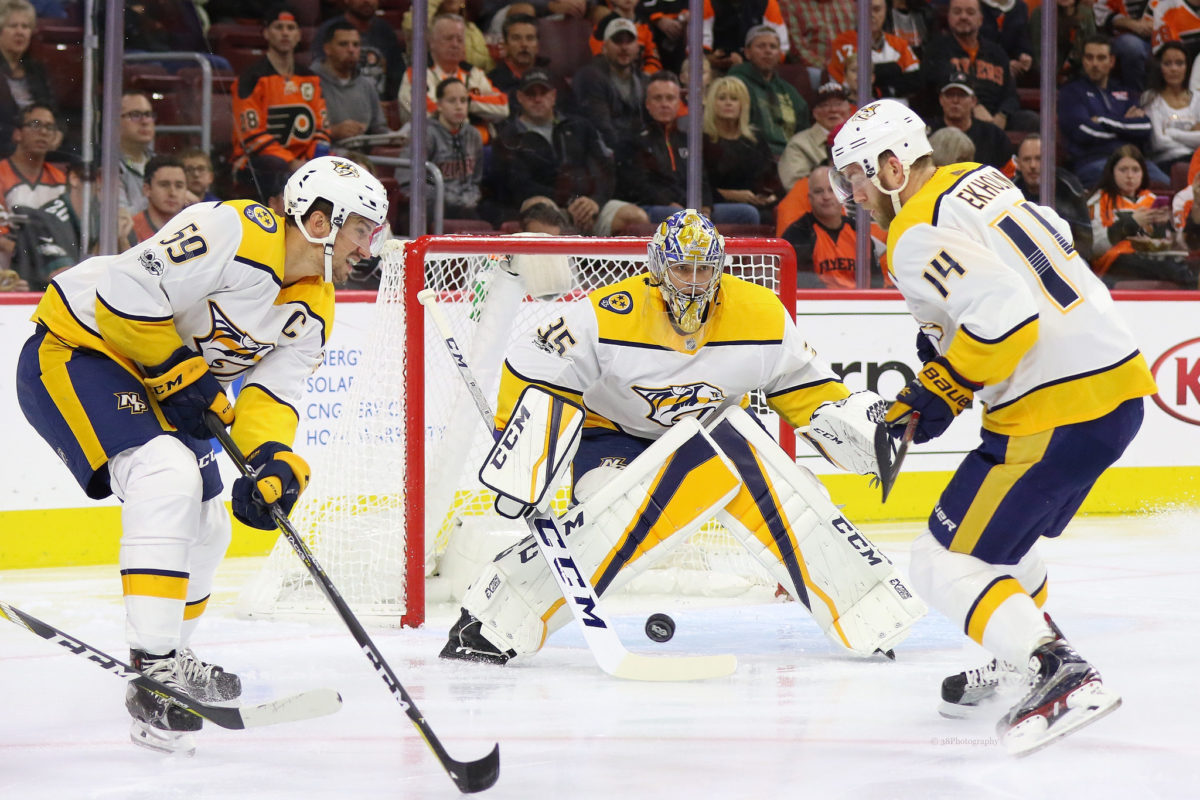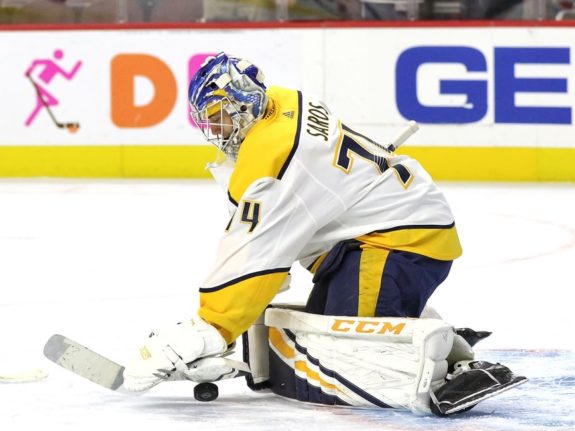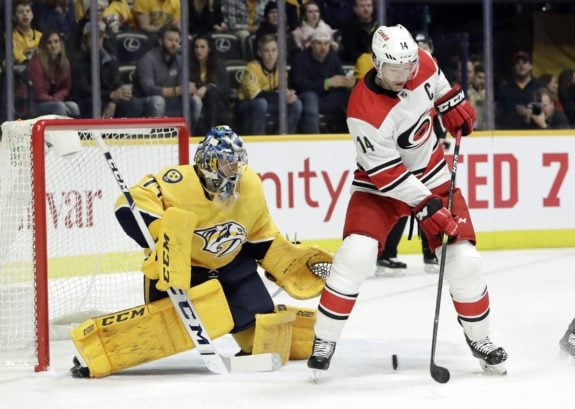Juuse Saros and Pekka Rinne have been a dynamic duo in net for half a decade as of the 2020-21 season. The two Finns were once regarded as a top tandem in the league, however, Rinne is not his vintage self anymore. This fact might be hard for the dedicated Rinne fans out there who are clinging to hope with an iron grip, but nothing has become more evident since his miraculous Vezina Trophy in the 2017-18 season.
For starters, Rinne is not performing well by the eye-test. He often overcommits on pucks, which puts him at a disadvantage for rebound chances. Pair that with his increasingly consistent knack of letting in soft goals and it’s no wonder that there has been some concern among Preds fans and media alike.

Also, the statistics speak for themselves, as Rinne is hovering around average in terms of save percentage (SV%) at .907 from 2018-21. For context, the three years prior (2015-18), his SV% was .918. In goals saved above expected (GSAx) per Evolving-Hockey, he is at minus-23.99 from 2018-21. Whereas from 2015-18, he posted a minus-7.43 GSAx, which is not great by any means, but still better than his most recent performances.
Rinne’s inevitable downturn has led to the transition of Saros taking the reins. He has been a top backup in the league, and with Rinne ending his career soon, it appears as if the crease will be his full-time until Yaroslav Askarov comes over from Russia. Saros played hockey in the Finnish U-20 Liiga before being drafted by the Predators in 2013, and went on to play two more seasons in the Liiga before coming over to the US.
Despite control of the blue ice gradually being handed to Saros, there are still some flaws that can be easily exacerbated by opponents. Outside of his discouraging build relative to his peers, Saros has shown a concerning pattern of slowly starting the season. Some might not be worried, but others are fearful that Saros might not be the goaltender we all thought he was. This begs the question: how bad have Saros’ early starts been?
Saros’ Poor Early Numbers
Saros is an electric yet simple presence in the crease. As I alluded to in the last paragraph, he is a small goaltender. At a stout 5-foot-11, Saros has to play much bigger than he is. This playstyle is hugely evident in shootout situations; Saros starts in the center of the net, and as the shooter moves down the ice, he pushes himself almost to the hash marks, where he begins his backwards motion. This strategy is all in an attempt to cover the angles and hinder the shooter’s vision. Brass around the league have expressed concern because of his height, but most of the Predators’ faithful are confident in Saros. However, despite the faith in “little Pekka,” some are concerned that his early-season numbers could hinder the team from getting out of the gate fast.
The concern is not unwarranted. His month-by-month splits in the early season relative to later are confusing. Looking back at the 2017-18 season, when Saros played as a backup full-time, he played three games in October and was shelled for 13 goals against. He went 0-3-0 with a .813 SV% and 4.13 goals-against average (GAA). He had an ugly -5.69 GSAx in those three games, including a -4.19 in one outing alone. His delta Fenwick save percentage (dFSV%) was even uglier at -14.62%.
Luckily, Rinne was playing so well that the team was not hindered entirely by a poor first month from their esteemed backup. After a rough trifecta of games to start the year, Saros bounced back in two games with a .920 SV%, 2.80 GAA, 0.67 GSAx, and a 1.32 dFSV%. For the rest of the 2017-18 season, Saros didn’t drop below a .915 SV% in any month. This is just a minor representation of Saros’ play and the inconsistencies.

Overall, Saros has a 16-17-3 record in the first two months of the season, which makes up almost half of his total losses in the 2018-21 span. When looking over Saros’ first two months since 2017-18, he has conceded 122 goals on 1,111 shots for a .890 SV%; This could be for several reasons. Some might suggest he needs to settle in first, and while it could be somewhat accurate, it lacks any deep analysis.
Using the same sample size as before, I calculated how many of his starts from 2017-18 to 2019-20 were top 15 in expected goals against (xGA) in all situations; Since 2021 isn’t over yet, I used the top 10. Out of 42 games played in the first two months, 20 (13 from 2017-20 and seven in 2021) were within those specific parameters in xGA. Comparatively, Rinne has 64 games played in the first two months and has fewer games with placements in the top 15 in xGA from 2017-20 and top 10 in 2021, with 14 in total. Those numbers represent two more prominent points: the defense in front of Saros within those first two months is not good, and the defense in front of Rinne has been worlds better to start the season.
Early Season Write-Offs Are Ill-Advised
Saros’ starts to the season have not been good, and it isn’t unreasonable for Preds fans or management to question his performance or future with the team, especially with the drafting of Askarov. As with any numbers, a slow start can be detrimental to a season both for the team and goalie. A slow start at the average SV% of Saros over the first two months could be the difference between a Vezina season and just a great season.
Despite that fact, questioning Saros as a goaltender is misguided. He has still proven that he can perform over an entire season and can be relied upon down the stretch. Saros will never be Rinne, and that expectation is also misguided. However, even if he can’t be Rinne, nothing is stopping Saros from being a top-tier starter for the next few years.

Of course, it would be beneficial for Saros’ overall numbers and the Predators’ record to figure out these early slumps. However, it is essentially a self-inflicted wound on the Predators’ part. If the defense, for whatever reason, plays better in front of one goalie than the other at the beginning of the year, it’s hard to blame one individual player. Goalies are always the scapegoat for poor team performance, and in this instance, Saros doesn’t play as well at the start of the season as he does in the latter. The problem is using this very short month to two-month sample as a reason to write him off entirely.